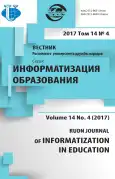ON THE USE OF BILINGUAL TECHNOLOGIES IN THE PROCESS OF LEARNING ENGLISH THE LANGUAGE IN HIGH SCHOOL
- 作者: Grigorieva KS1, Yakhina RR2
-
隶属关系:
- Kazan (Privolzhskij) federal university
- The Kazan national research technical the university named after A.N. Tupolev - KAI
- 期: 卷 14, 编号 4 (2017)
- 页面: 484-492
- 栏目: INNOVATION PEDAGOGICAL TECHNOLOGIES IN EDUCATION
- URL: https://journal-vniispk.ru/2312-8631/article/view/333560
- DOI: https://doi.org/10.22363/2312-8631-2017-14-4-484-492
- ID: 333560
如何引用文章
全文:
详细
At present, the application of information and communication technologies (ICT) in learning English in high school proved its effectiveness. The article presents the differentiation of the concepts of CLIL (Content and Language Integrated Learning) and EMI (English as a Medium of Instruction) and given the definitions of these terms; the choice of educational technologies CLIL. Analyzed psychological and psycholinguistic problems in the learning process of students and possible ways of their solution. The article discusses the possibility of using Internet resources as a means of learning within CLIL.
作者简介
K Grigorieva
Kazan (Privolzhskij) federal university
编辑信件的主要联系方式.
Email: grigks@yandex.ru
Grigorieva Ksenia Sergeevna, candidate of pedagogical sciences, senior lecturer of the department of educational technology and information systems in Philology, Kazan (Privolzhskij) Federal University.
Kremlevskaya str., 18, Kazan, Republic of Tatarstan, Russia, 420008R Yakhina
The Kazan national research technical the university named after A.N. Tupolev - KAI
Email: shroza1981@yandex.ru
Yakhina Ruzilya Raifovna, candidate of philological sciences, associate professor of foreign languages department of Kazan national research technical the university named after A.N. Tupolev - KAI.
K. Marx str., 10, Kazan, Republic of Tatarstan, Russia, 420111参考
- Grigorieva K.S., Yakhina R.R. Ob opyte ispol’zovanija tehnologii predmetno-jazykovogo integrirovannogo obuchenija CLIL [About experience of use of technology of the subject and language integrated CLIL training]. Sovremennye issledovanija osnovnyh napravlenij gumanitarnyh i estestvennyh nauk: materialy mezhdunarodnoj nauchno-prakticheskoj konferencii [Modern researches of the main directions of humanitarian and natural sciences: materials of the international scientific and practical conference]. 2017. Pp. 126—131.
- Salekhova L.L. Kognitivnye izderzhki bilingval’nogo obuchenija [Cognitive expenses of bilingual training]. Filologija i kul’tura [Philology and culture]. 2015. No. 2 (40). Pp. 314—320.
- Coyle D., Hood Ph., Marsh D. CLIL Content and Language Integrated Learning. Cambridge: Cambridge University Press, 2010. 173 p.
- Cummins J. (2000). Putting language proficiency in its place: Responding to critiques of the conversational /academic language distinction // English in Europe: The Acquisition of a third Language. Clevedon.
- Dearden J. (2014). English as a medium of instruction — a growing global phenomenon. URL: https://www.britishcouncil.org/sites/default/files/e484_emi_-_cover_option_3_final_web.pdf
- Grigorieva K., Salekhova L. Social networks in teaching English for Specific Purposes // 11th International Technology, Education and Development Conference, Valencia, Spain, 6—8 March, 2017. Pp. 0500—0502.
- Marsh D. (2002). Content and Language Integrated Learning: the European Dimension — Actions, Trends and Foresight potential.
- Novikova S., Sosnovsky S., Yakhina R., Valitova N., Kremleva E. The specific aspects of designing computer-based tutors for future engineers in numerical methods studying // Интеграция образования. 2017. Т. 21. № 2 (87). С. 322—343.
- The Glossary of Education Reform. URL: http://edglossary.org/scaffolding/
补充文件









